
views
Lighting and Extinguishing the Lamp
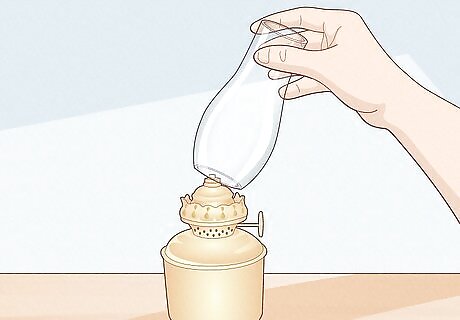
Twist off the lamp’s chimney to access the wick and font. The burner, which contains the wick, and the font, also known as the fuel chamber, are located at the bottom of the lamp. To access them, gently twist the chimney counterclockwise. It’s the large glass spout that protects the flame. Kerosene lamps come in different shapes and sizes, so the removal process may vary slightly. If your lamp has a handle, lift it up first. Then you should be able to twist off the chimney.
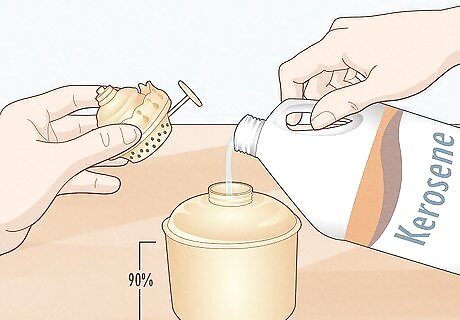
Pour lamp oil into the font until it is 90% full. The font is the lamp’s base and will have a round metal burner on top of it. Twist the burner sleeve counterclockwise to remove it. Then, pour the lamp oil directly into the hole where the burner sleeve was. Use a plastic funnel to help get the oil into the font, then wipe up any spillage with a paper towel. Avoid filling the font completely full. Cold kerosene expands as it warms and can overflow. Some burners have a side fuel valve you can use to easily add fuel. However, keep the oil level below the valve. You have a few fuel options. Kerosene is a basic fuel that smells pretty nasty indoors. Paraffin is similar but is more solid, evaporates faster, and can clog up your burner over time. Lamp oil is kerosene that has been purified so it can be used indoors.
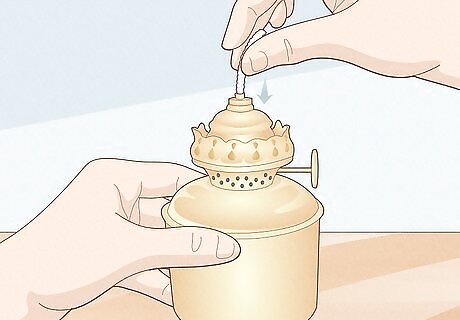
Install the burner sleeve and fit the wick snugly into it. The metal burner you removed earlier will have a slot for the wick, which is easy to install. First, place the burner back on the font, turning it clockwise to lock it in place. Then, position the wick directly into the slot. It will hang down into the fuel chamber. The wick should fit snugly in the burner sleeve. If it is too tight, the wick may not draw up enough fuel. If it is too loose, the flame may flicker out or burn down the wick. You can buy wicks online or in some camping supply stores. You can also make your own wicks by installing strands of cotton or other material. You may need to sew strands together to make the wick the size you need.
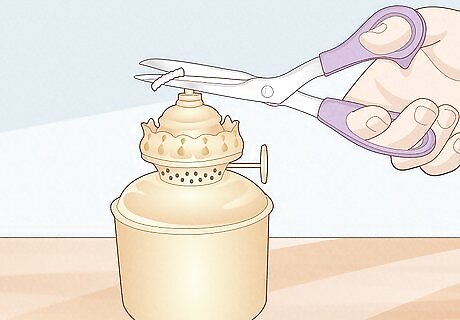
Cut the top of the wick so it is even with the burner sleeve. Use a sharp pair of scissors to cut the top off the wick. Simply trim straight across the wick to ensure it burns evenly. Remove any loose threads you notice. You can shape the wick by rounding its corners a little. This may protect your lamp from overheating, but cutting the wick straight across is far easier and works well enough.
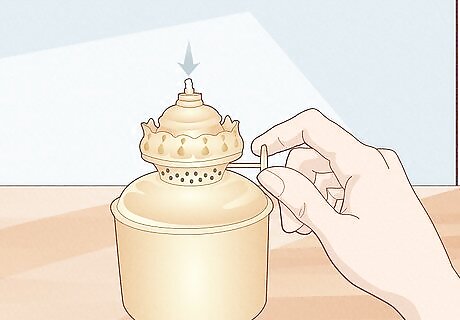
Lower the wick until it barely sticks out of the burner sleeve. Some kerosene lamps have a knob on the outside that controls the wick. Turn the dial clockwise to raise the wick and counterclockwise to lower it. Adjust the wick until you can just see the tip poking out of the burner. If your lamp doesn’t have a wick control knob, adjust the wick by hand. Either trim it to size or pull it further down into the font.
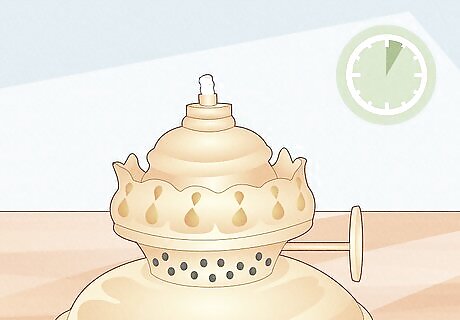
Allow the wick to soak for up to 1 hour. The wick will absorb the oil during this time. You may be able to light your lamp before an hour has passed. For a good burn, however, the wick needs to be coated completely in the oil.
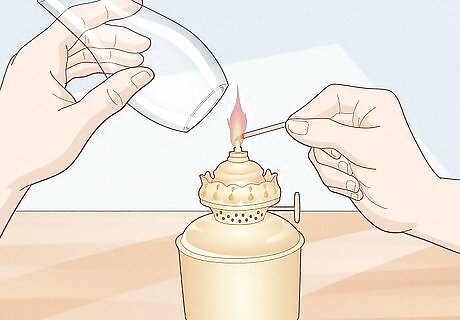
Light the wick and place the chimney over it. Strike a match or cigarette lighter, then touch the flame to the wick. The wick should catch fire right away. You can then fit the glass chimney back over the lamp’s base. Turn the chimney clockwise until it locks in place, or else you may end up dropping it when you try to move the lamp. Some lamps have a lighter hole on the outside. While the chimney is in place, you can stick a match through the hole to light the wick.
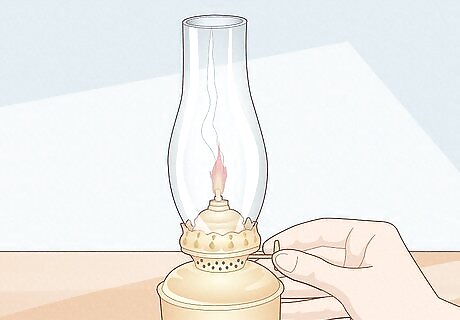
Turn the wick down if the lamp begins to smoke. Smoking is normal, particularly with tube-shaped lamps. However, smoke and steam are a sign of excess heat than can damage the lamp’s glass. Use the wick dial to lower the wick, keeping the flame at a low, dim glow. As the lamp heats up, you can turn the wick back up to get a brighter light. Smoke and steam often happen in cold rooms. The lamp’s chimney is cold, so sudden heat exposure can cause it to crack. Warming it up gradually with a low flame prevents this.
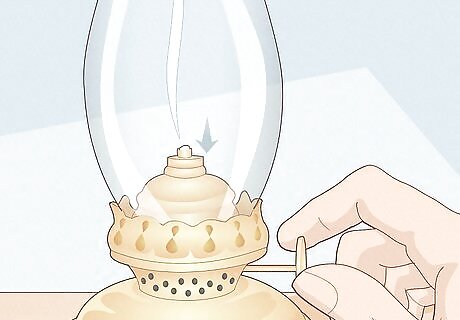
Turn the wick down to extinguish the flame. When you are done using the lamp, try lowering the wick until you can no longer see the flame. This usually is enough to extinguish the flame. If the flame is still there, cup your hands above the top of the chimney. Keep your face away from the chimney, but blow a quick puff of air towards it to extinguish the flame. Avoid touching the glass. It may feel very hot. Also, blowing down into the chimney may damage it. Whatever you do, don’t let a kerosene lamp continue to burn. Not only does a lit lamp burn up fuel, but it poses a fire hazard if you aren’t paying attention to it.
Cleaning and Storing the Lamp
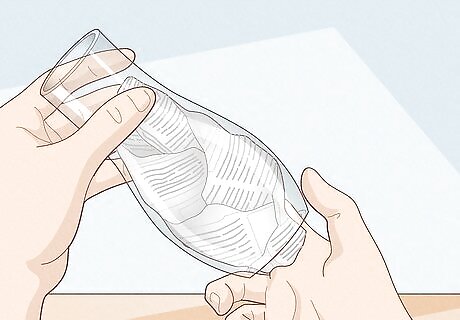
Clean and dry the chimney after using the lamp. Newspaper is good for keeping your lamp clean. Make sure the lamp’s flame is off and has had time to cool. Remove the chimney, then wipe off all the soot inside of it. Doing this ensures your lamp burns brightly and safely. Most soot comes off easily. For stubborn soot, dampen the newspaper a little first. You can rinse out the chimney using lukewarm water in your sink. Be careful to avoid breaking the glass. Avoid lighting up a wet chimney. The steam caused by the fire can lead to broken glass.
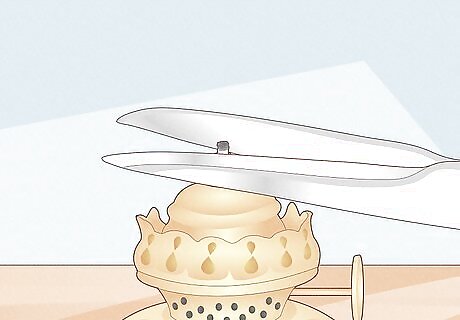
Cut the charred top off the wick after using it. Always trim the wick before lighting up your lamp. The flame will turn the top end of the wick black. Using a sharp pair of scissors, cut across the wick to prepare it for use again. You can also round the corners of the wick to help it burn. Make sure you remove all of the charred bits first.
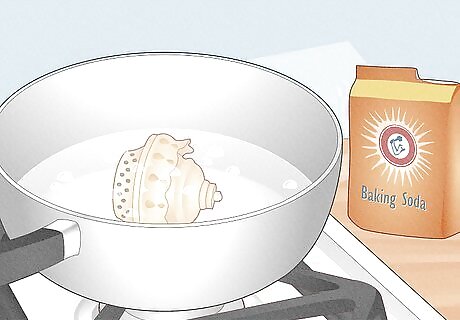
Soak dirty burners in water and baking soda to prevent clogs. Remove the wick and pour out any oil before attempting to clean the burner. In a pot, boil equal parts water and baking soda. Add the burner and let it soak until it is clean. For greater effect, scrub the burner with a kitchen brush afterwards. Dirty burners may need to be soaked in the mixture overnight. Clean the burner about once a month to prevent soot buildup. You can also use metal cleaners from the hardware store. Rinse off the cleaner, then use a hair dryer to dry the burner completely before using it again.
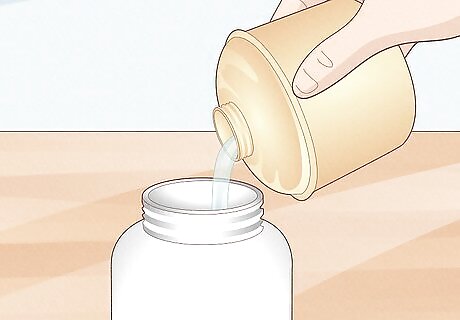
Pour out excess fuel if you plan on storing the lamp. If you don’t expect to use the lamp for a while, such as within 2 to 3 months, put the oil in a safe container. Use a clean, resealable container and label it so you know it has kerosene in it. Remove the chimney and fuel burner from the lamp, then pour the remaining fuel into your container. Cheap plastic containers degrade quickly, so don’t store oil in them long-term. Instead, get a blue gas canister. Many retailers use blue containers to represent kerosene since red is typically reserved for regular gasoline and yellow for diesel. Avoid using glass containers since they let in light and heat. Kerosene is less likely to explode than gasoline, but avoid the risk by staying away from glass. Kerosene is a stable fuel that stores well in any temperature. Compared to gasoline, it is less prone to freezing or evaporating.
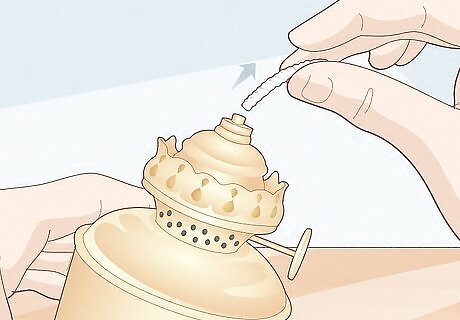
Remove the wick if you put the lamp in storage. Pull the wick out of the burner. After clearing the oil out of the lamp’s font, you can lay the wick there. You can also drape the wick over the burner, then place the chimney back over it. If you do this, store the lamp out of the reach of children to avoid any accidents. The wick will be coated in oil, so store it away from heat. Once you need your lamp again, you can put the wick back in the burner and light it up.




















Comments
0 comment